Influence of Sea Levels on Rio de Janeiro Coastlines - Analysis
VerifiedAdded on 2023/06/09
|5
|1190
|167
Essay
AI Summary
This essay examines the influence of rising sea levels on coastlines, focusing on Rio de Janeiro, Brazil. It discusses how factors like waves, currents, and tides shape coastlines and how rising sea levels exacerbate these effects. The essay highlights the potential for coastal inundation, increased flooding, salinization of groundwater, and loss of coastline due to global warming and human activities. It emphasizes the importance of addressing global warming to protect coastal areas and maintain biodiversity, suggesting measures to reduce carbon footprints and use natural resources efficiently to mitigate the harmful effects of rising sea levels on vulnerable coastal regions like Rio de Janeiro.
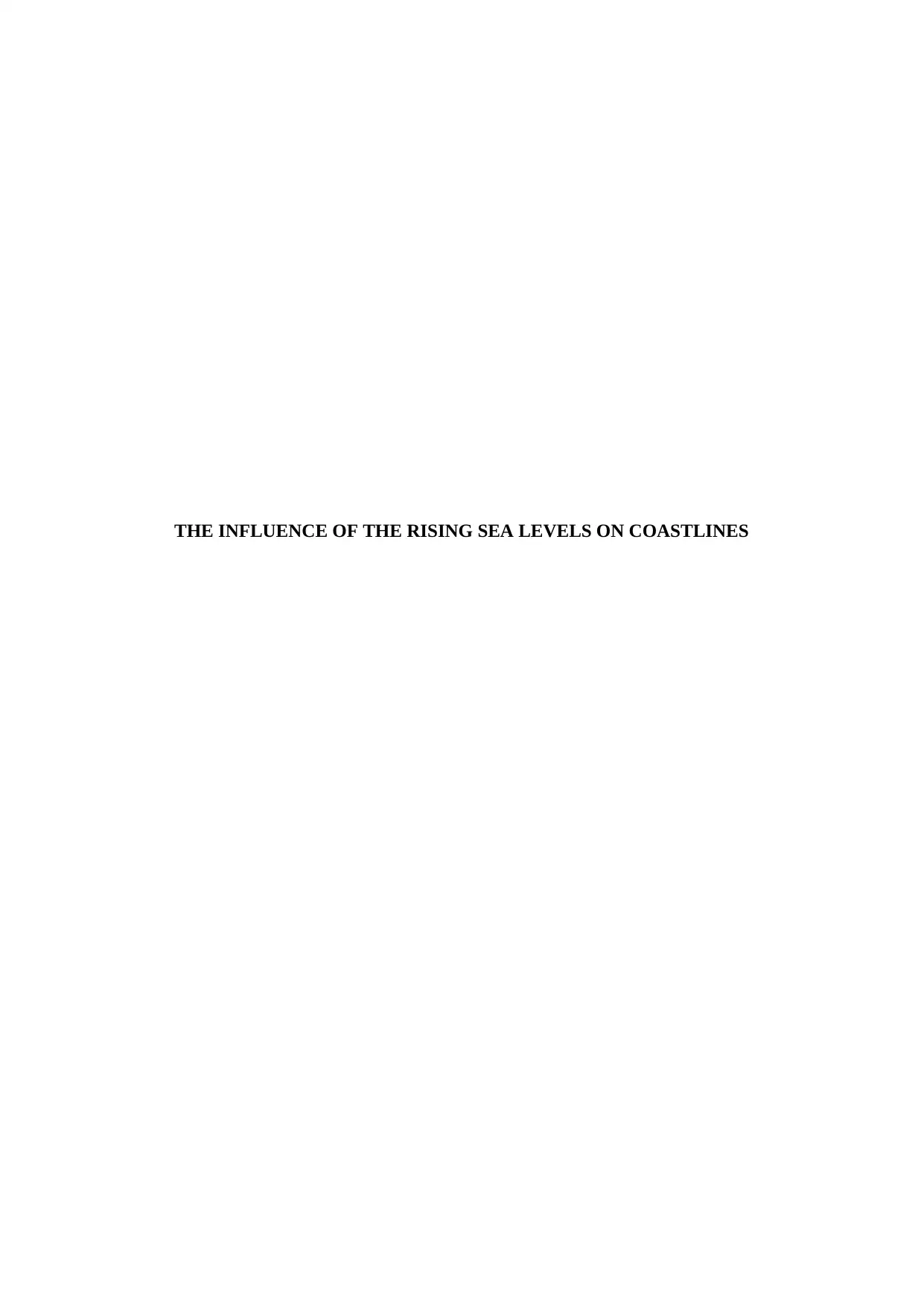
THE INFLUENCE OF THE RISING SEA LEVELS ON COASTLINES
Paraphrase This Document
Need a fresh take? Get an instant paraphrase of this document with our AI Paraphraser
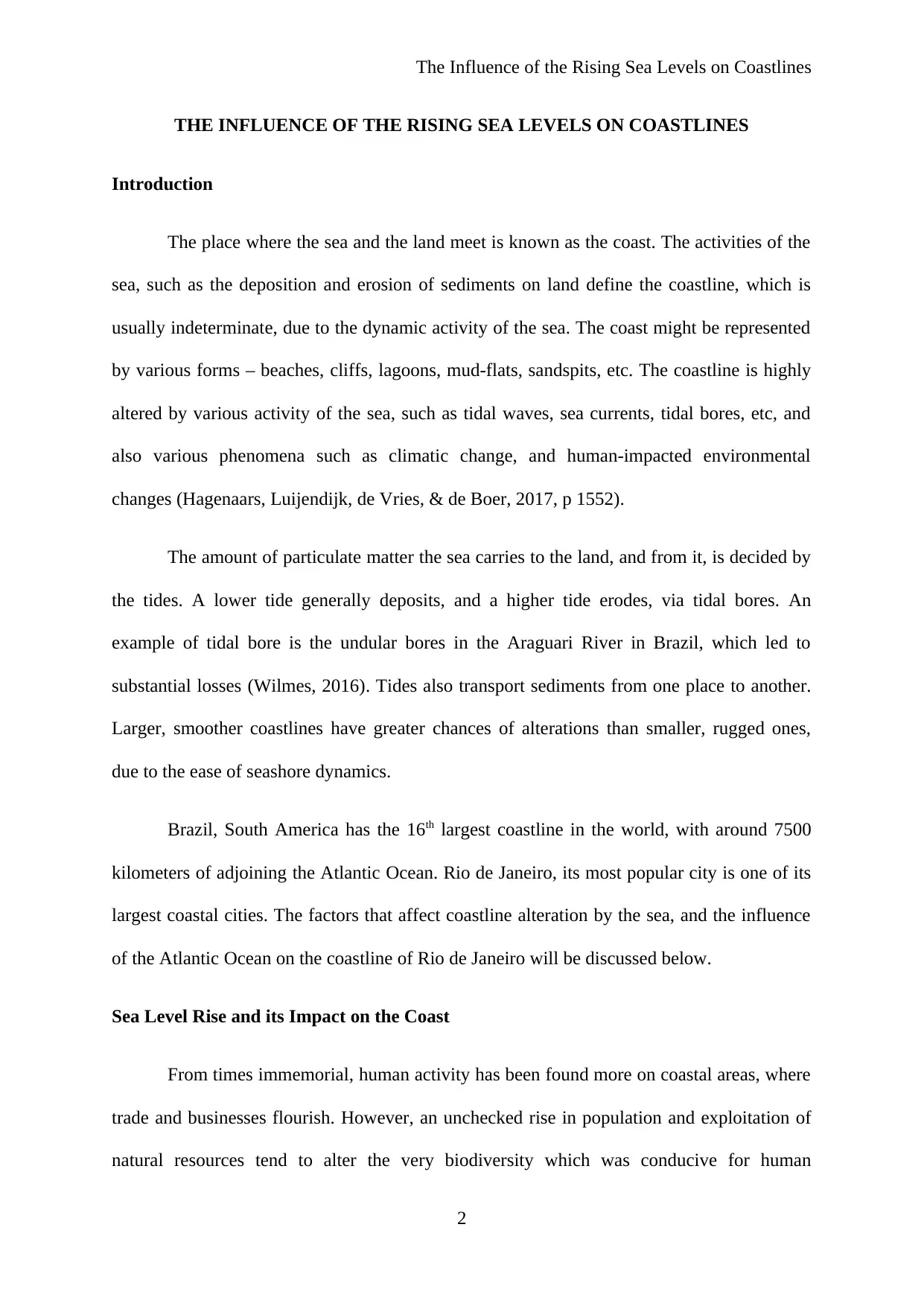
The Influence of the Rising Sea Levels on Coastlines
THE INFLUENCE OF THE RISING SEA LEVELS ON COASTLINES
Introduction
The place where the sea and the land meet is known as the coast. The activities of the
sea, such as the deposition and erosion of sediments on land define the coastline, which is
usually indeterminate, due to the dynamic activity of the sea. The coast might be represented
by various forms – beaches, cliffs, lagoons, mud-flats, sandspits, etc. The coastline is highly
altered by various activity of the sea, such as tidal waves, sea currents, tidal bores, etc, and
also various phenomena such as climatic change, and human-impacted environmental
changes (Hagenaars, Luijendijk, de Vries, & de Boer, 2017, p 1552).
The amount of particulate matter the sea carries to the land, and from it, is decided by
the tides. A lower tide generally deposits, and a higher tide erodes, via tidal bores. An
example of tidal bore is the undular bores in the Araguari River in Brazil, which led to
substantial losses (Wilmes, 2016). Tides also transport sediments from one place to another.
Larger, smoother coastlines have greater chances of alterations than smaller, rugged ones,
due to the ease of seashore dynamics.
Brazil, South America has the 16th largest coastline in the world, with around 7500
kilometers of adjoining the Atlantic Ocean. Rio de Janeiro, its most popular city is one of its
largest coastal cities. The factors that affect coastline alteration by the sea, and the influence
of the Atlantic Ocean on the coastline of Rio de Janeiro will be discussed below.
Sea Level Rise and its Impact on the Coast
From times immemorial, human activity has been found more on coastal areas, where
trade and businesses flourish. However, an unchecked rise in population and exploitation of
natural resources tend to alter the very biodiversity which was conducive for human
2
THE INFLUENCE OF THE RISING SEA LEVELS ON COASTLINES
Introduction
The place where the sea and the land meet is known as the coast. The activities of the
sea, such as the deposition and erosion of sediments on land define the coastline, which is
usually indeterminate, due to the dynamic activity of the sea. The coast might be represented
by various forms – beaches, cliffs, lagoons, mud-flats, sandspits, etc. The coastline is highly
altered by various activity of the sea, such as tidal waves, sea currents, tidal bores, etc, and
also various phenomena such as climatic change, and human-impacted environmental
changes (Hagenaars, Luijendijk, de Vries, & de Boer, 2017, p 1552).
The amount of particulate matter the sea carries to the land, and from it, is decided by
the tides. A lower tide generally deposits, and a higher tide erodes, via tidal bores. An
example of tidal bore is the undular bores in the Araguari River in Brazil, which led to
substantial losses (Wilmes, 2016). Tides also transport sediments from one place to another.
Larger, smoother coastlines have greater chances of alterations than smaller, rugged ones,
due to the ease of seashore dynamics.
Brazil, South America has the 16th largest coastline in the world, with around 7500
kilometers of adjoining the Atlantic Ocean. Rio de Janeiro, its most popular city is one of its
largest coastal cities. The factors that affect coastline alteration by the sea, and the influence
of the Atlantic Ocean on the coastline of Rio de Janeiro will be discussed below.
Sea Level Rise and its Impact on the Coast
From times immemorial, human activity has been found more on coastal areas, where
trade and businesses flourish. However, an unchecked rise in population and exploitation of
natural resources tend to alter the very biodiversity which was conducive for human
2
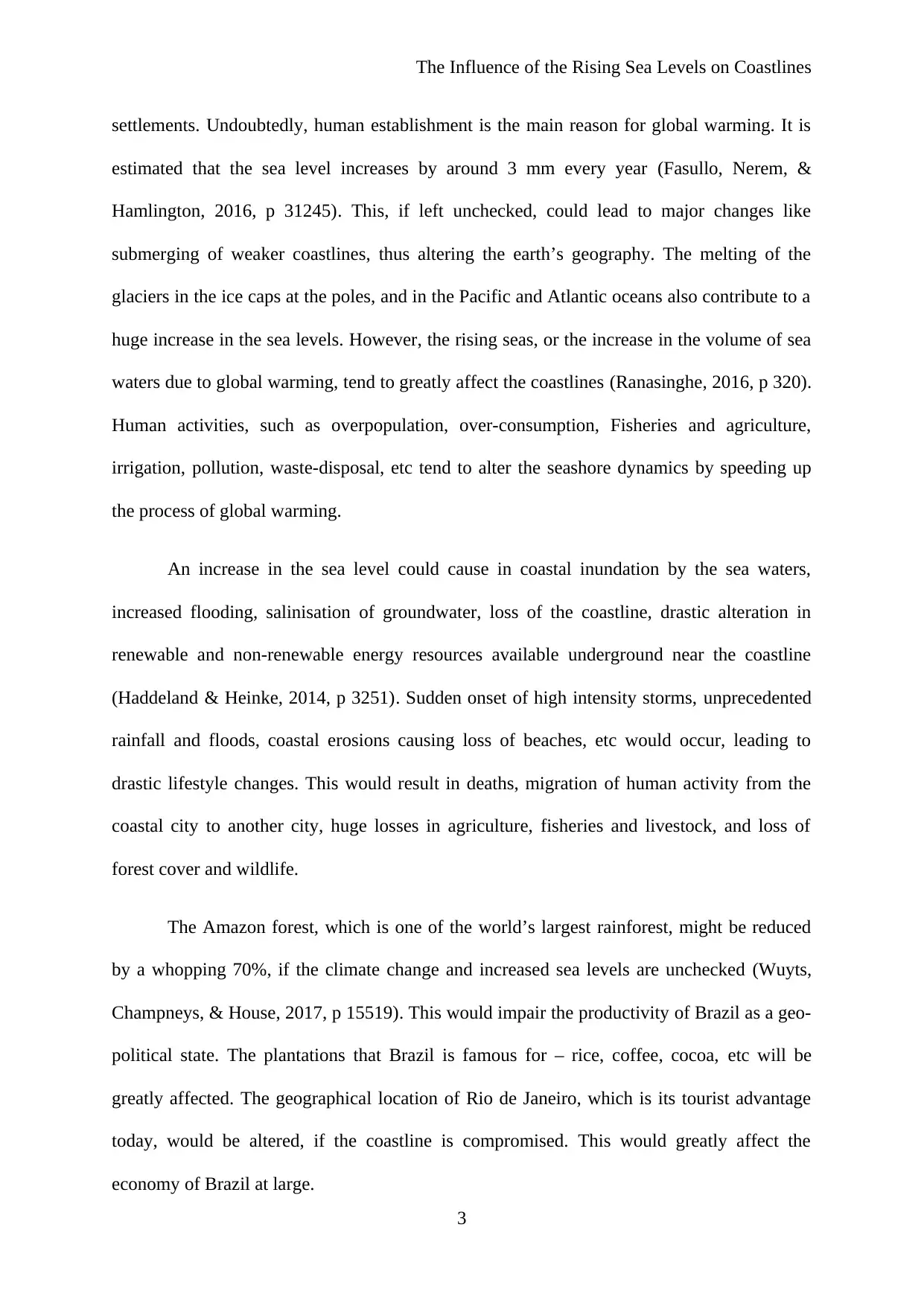
The Influence of the Rising Sea Levels on Coastlines
settlements. Undoubtedly, human establishment is the main reason for global warming. It is
estimated that the sea level increases by around 3 mm every year (Fasullo, Nerem, &
Hamlington, 2016, p 31245). This, if left unchecked, could lead to major changes like
submerging of weaker coastlines, thus altering the earth’s geography. The melting of the
glaciers in the ice caps at the poles, and in the Pacific and Atlantic oceans also contribute to a
huge increase in the sea levels. However, the rising seas, or the increase in the volume of sea
waters due to global warming, tend to greatly affect the coastlines (Ranasinghe, 2016, p 320).
Human activities, such as overpopulation, over-consumption, Fisheries and agriculture,
irrigation, pollution, waste-disposal, etc tend to alter the seashore dynamics by speeding up
the process of global warming.
An increase in the sea level could cause in coastal inundation by the sea waters,
increased flooding, salinisation of groundwater, loss of the coastline, drastic alteration in
renewable and non-renewable energy resources available underground near the coastline
(Haddeland & Heinke, 2014, p 3251). Sudden onset of high intensity storms, unprecedented
rainfall and floods, coastal erosions causing loss of beaches, etc would occur, leading to
drastic lifestyle changes. This would result in deaths, migration of human activity from the
coastal city to another city, huge losses in agriculture, fisheries and livestock, and loss of
forest cover and wildlife.
The Amazon forest, which is one of the world’s largest rainforest, might be reduced
by a whopping 70%, if the climate change and increased sea levels are unchecked (Wuyts,
Champneys, & House, 2017, p 15519). This would impair the productivity of Brazil as a geo-
political state. The plantations that Brazil is famous for – rice, coffee, cocoa, etc will be
greatly affected. The geographical location of Rio de Janeiro, which is its tourist advantage
today, would be altered, if the coastline is compromised. This would greatly affect the
economy of Brazil at large.
3
settlements. Undoubtedly, human establishment is the main reason for global warming. It is
estimated that the sea level increases by around 3 mm every year (Fasullo, Nerem, &
Hamlington, 2016, p 31245). This, if left unchecked, could lead to major changes like
submerging of weaker coastlines, thus altering the earth’s geography. The melting of the
glaciers in the ice caps at the poles, and in the Pacific and Atlantic oceans also contribute to a
huge increase in the sea levels. However, the rising seas, or the increase in the volume of sea
waters due to global warming, tend to greatly affect the coastlines (Ranasinghe, 2016, p 320).
Human activities, such as overpopulation, over-consumption, Fisheries and agriculture,
irrigation, pollution, waste-disposal, etc tend to alter the seashore dynamics by speeding up
the process of global warming.
An increase in the sea level could cause in coastal inundation by the sea waters,
increased flooding, salinisation of groundwater, loss of the coastline, drastic alteration in
renewable and non-renewable energy resources available underground near the coastline
(Haddeland & Heinke, 2014, p 3251). Sudden onset of high intensity storms, unprecedented
rainfall and floods, coastal erosions causing loss of beaches, etc would occur, leading to
drastic lifestyle changes. This would result in deaths, migration of human activity from the
coastal city to another city, huge losses in agriculture, fisheries and livestock, and loss of
forest cover and wildlife.
The Amazon forest, which is one of the world’s largest rainforest, might be reduced
by a whopping 70%, if the climate change and increased sea levels are unchecked (Wuyts,
Champneys, & House, 2017, p 15519). This would impair the productivity of Brazil as a geo-
political state. The plantations that Brazil is famous for – rice, coffee, cocoa, etc will be
greatly affected. The geographical location of Rio de Janeiro, which is its tourist advantage
today, would be altered, if the coastline is compromised. This would greatly affect the
economy of Brazil at large.
3
⊘ This is a preview!⊘
Do you want full access?
Subscribe today to unlock all pages.

Trusted by 1+ million students worldwide
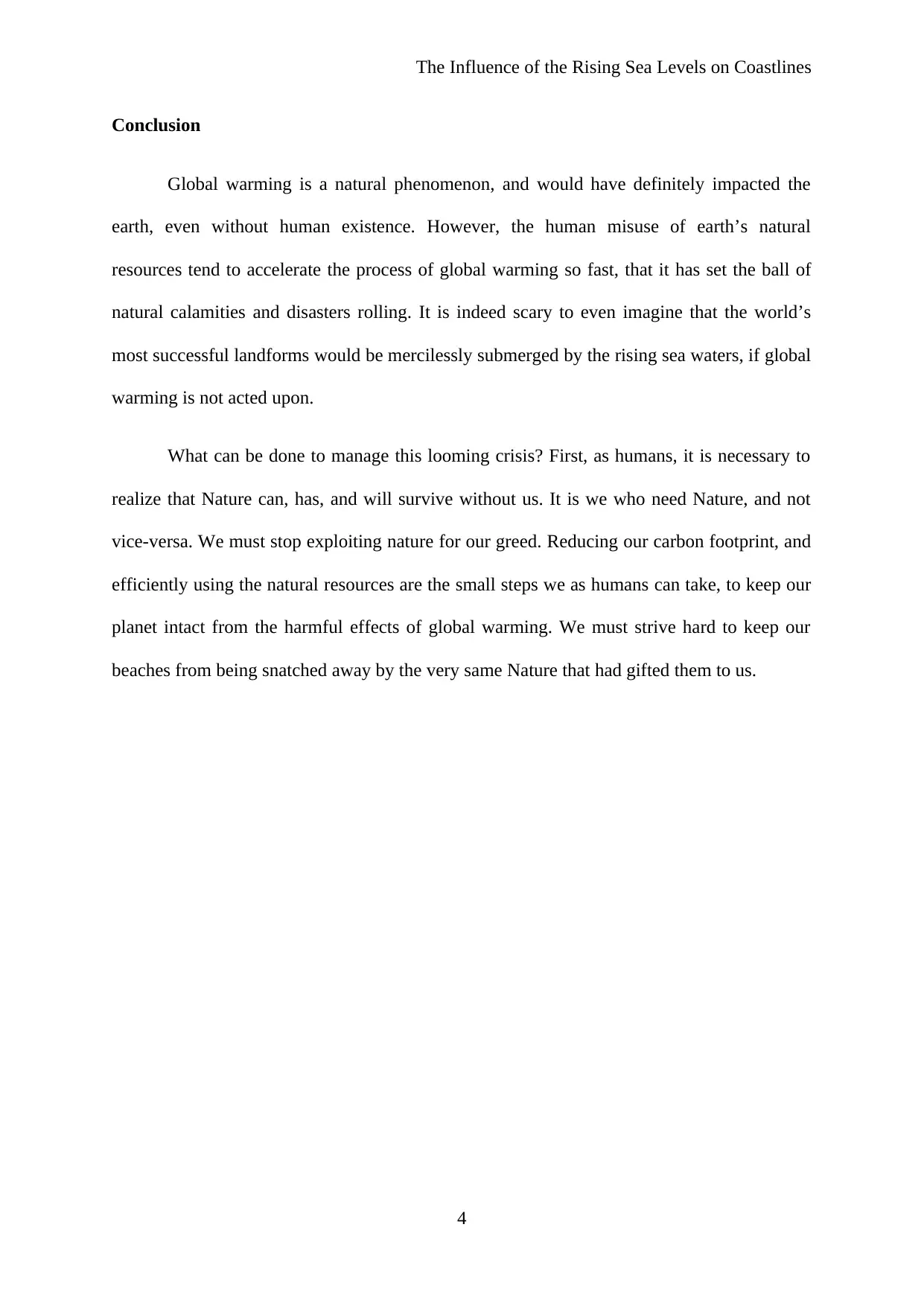
The Influence of the Rising Sea Levels on Coastlines
Conclusion
Global warming is a natural phenomenon, and would have definitely impacted the
earth, even without human existence. However, the human misuse of earth’s natural
resources tend to accelerate the process of global warming so fast, that it has set the ball of
natural calamities and disasters rolling. It is indeed scary to even imagine that the world’s
most successful landforms would be mercilessly submerged by the rising sea waters, if global
warming is not acted upon.
What can be done to manage this looming crisis? First, as humans, it is necessary to
realize that Nature can, has, and will survive without us. It is we who need Nature, and not
vice-versa. We must stop exploiting nature for our greed. Reducing our carbon footprint, and
efficiently using the natural resources are the small steps we as humans can take, to keep our
planet intact from the harmful effects of global warming. We must strive hard to keep our
beaches from being snatched away by the very same Nature that had gifted them to us.
4
Conclusion
Global warming is a natural phenomenon, and would have definitely impacted the
earth, even without human existence. However, the human misuse of earth’s natural
resources tend to accelerate the process of global warming so fast, that it has set the ball of
natural calamities and disasters rolling. It is indeed scary to even imagine that the world’s
most successful landforms would be mercilessly submerged by the rising sea waters, if global
warming is not acted upon.
What can be done to manage this looming crisis? First, as humans, it is necessary to
realize that Nature can, has, and will survive without us. It is we who need Nature, and not
vice-versa. We must stop exploiting nature for our greed. Reducing our carbon footprint, and
efficiently using the natural resources are the small steps we as humans can take, to keep our
planet intact from the harmful effects of global warming. We must strive hard to keep our
beaches from being snatched away by the very same Nature that had gifted them to us.
4
Paraphrase This Document
Need a fresh take? Get an instant paraphrase of this document with our AI Paraphraser
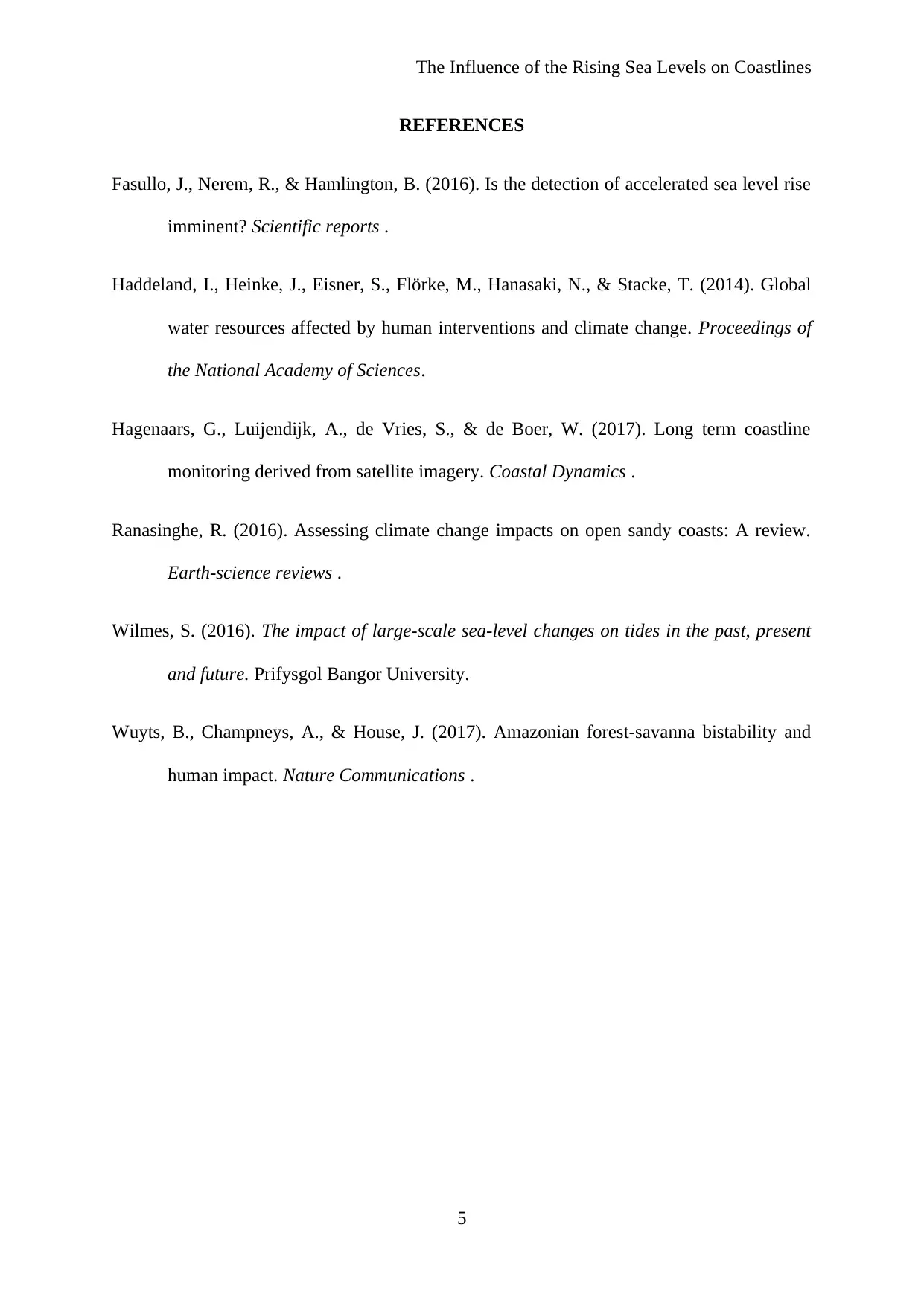
The Influence of the Rising Sea Levels on Coastlines
REFERENCES
Fasullo, J., Nerem, R., & Hamlington, B. (2016). Is the detection of accelerated sea level rise
imminent? Scientific reports .
Haddeland, I., Heinke, J., Eisner, S., Flörke, M., Hanasaki, N., & Stacke, T. (2014). Global
water resources affected by human interventions and climate change. Proceedings of
the National Academy of Sciences.
Hagenaars, G., Luijendijk, A., de Vries, S., & de Boer, W. (2017). Long term coastline
monitoring derived from satellite imagery. Coastal Dynamics .
Ranasinghe, R. (2016). Assessing climate change impacts on open sandy coasts: A review.
Earth-science reviews .
Wilmes, S. (2016). The impact of large-scale sea-level changes on tides in the past, present
and future. Prifysgol Bangor University.
Wuyts, B., Champneys, A., & House, J. (2017). Amazonian forest-savanna bistability and
human impact. Nature Communications .
5
REFERENCES
Fasullo, J., Nerem, R., & Hamlington, B. (2016). Is the detection of accelerated sea level rise
imminent? Scientific reports .
Haddeland, I., Heinke, J., Eisner, S., Flörke, M., Hanasaki, N., & Stacke, T. (2014). Global
water resources affected by human interventions and climate change. Proceedings of
the National Academy of Sciences.
Hagenaars, G., Luijendijk, A., de Vries, S., & de Boer, W. (2017). Long term coastline
monitoring derived from satellite imagery. Coastal Dynamics .
Ranasinghe, R. (2016). Assessing climate change impacts on open sandy coasts: A review.
Earth-science reviews .
Wilmes, S. (2016). The impact of large-scale sea-level changes on tides in the past, present
and future. Prifysgol Bangor University.
Wuyts, B., Champneys, A., & House, J. (2017). Amazonian forest-savanna bistability and
human impact. Nature Communications .
5
1 out of 5
Your All-in-One AI-Powered Toolkit for Academic Success.
+13062052269
info@desklib.com
Available 24*7 on WhatsApp / Email
![[object Object]](/_next/static/media/star-bottom.7253800d.svg)
Unlock your academic potential
Copyright © 2020–2025 A2Z Services. All Rights Reserved. Developed and managed by ZUCOL.


